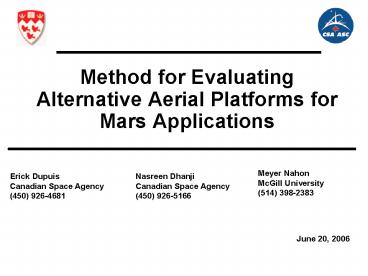Method for Evaluating Alternative Aerial Platforms for Mars Applications - PowerPoint PPT Presentation
1 / 23
Title:
Method for Evaluating Alternative Aerial Platforms for Mars Applications
Description:
Table 1. Mass Summary of Robotic Martian Airship. Gas Bag Volume (inflated): 16500 m3 ... Table 2. Specifications of the Robotic Martian Airship ... – PowerPoint PPT presentation
Number of Views:111
Avg rating:3.0/5.0
Title: Method for Evaluating Alternative Aerial Platforms for Mars Applications
1
Method for Evaluating Alternative Aerial
Platforms for Mars Applications
Meyer Nahon McGill University (514) 398-2383
Nasreen Dhanji Canadian Space Agency (450)
926-5166
Erick Dupuis Canadian Space Agency (450)
926-4681
June 20, 2006
2
Outline
- Case for Aerial Platforms on Mars
- Scientific Investigations on Mars
- Platform Configurations
- Performance Metrics
- Forward Work and Recommendations
3
Case for Aerial Platforms on Mars
- Bridge gap between orbital and ground-based
investigations of Mars - Advantages over Orbital Platforms
- Acquisition of ultra-high resolution data and
imagery - Sampling of atmospheric constituents
- Advantages over Surface Rovers
- Extended range
- Ability to traverse rough terrain that may be of
high geologic interest
4
Scientific Investigations on Mars Using Aerial
Platforms
- Mars Exploration Program Analysis Group (MEPAG)
Report - Consolidates NASA's key scientific goals,
objectives and investigations for Mars
exploration - Mars mission concepts based on 2003 MEPAG Report
- Search for water on Mars
- Study the Martian climate
- Perform mineralogical, thermophysical and
magnetic studies of Mars
5
Scientific Investigations on Mars Mission Concept
1
- Search for Water on Mars
- Objective
- Determine potential for life on Mars
- Instruments
- Ground Penetrating Radar (GPR) Search for
shallow water and ice deposits - High Resolution Stereo Camera (HRSC) Obtain
imagery of surface features providing evidence of
the presence or activity of water (e.g. overflow
channels)
6
Scientific Investigations on Mars Mission Concept
2
- Study the Martian Climate
- Objective
- Understanding the processes and history of
climate on Mars - Instruments
- Meteorology (MET) Package Simultaneous
measurements of temperature, pressure, wind and
humidity - Tunable Laser Spectrometer Measure atmospheric
gases active in the infrared spectrum - High Resolution Stereo Camera (HRSC) Monitor
dust cloud coverage
7
Scientific Investigations on Mars Mission Concept
3
- Mineralogical, Thermophysical and Magnetic Study
of Mars - Objective
- Determine the Evolution of the Surface and
Interior of Mars - Instruments
- Infrared Reflectance Spectrometer Mineralogy of
Martian surface and presence of frozen H2O and
CO2 - Tri-axial Fluxgate Magnetometer Measure the
crustal remnant magnetic field - Gravity Gradiometer Study gravity anomalies
associated with crustal density variations - High Resolution Stereo Camera (HRSC) Imagery of
large scale vertical structures
8
Aerial Platform Design Requirements
- Aerial platform design requirements derived from
mission requirements - Payload power/mass
- Aircraft speed
- Altitude
- Range
- Flight Path
9
Atmospheric Environment on Mars
10
Aerial Platform Configurations
- Types of Aerial Platforms
- Lighter-Than-Air
- Fixed-Wing Aircraft
- Rotary-Wing Aircraft
- Existing aerial platform designs
- Robotic Martian Airship (RMA)
- Daedalus 88
- Martian Autonomous Rotary-wing Vehicle (MARV)
- Potential scaling of aerial platforms
11
Lighter-Than-Air Robotic Martian Airship (RMA)
Envelope Fabric 126.3
kg Inflatable Tail 8.1 kg Rigging
Miscellaneous 24.6 kg Fuel 13.0 kg Fuel
System 2.6 kg Mass Engines 1.1
kg Hydrogen 14.0 kg Hydrogen Tank,
Temperature Control System, Inflation System
(Jettisoned) 13.8 kg Table 1. Mass Summary of
Robotic Martian Airship
Gas Bag Volume (inflated) 16500 m3 Factor of
Safety for Gas Bag 1.2 Total Mass of
Airship 199.66 kg Maximum Speed 10
m/s Duration 40 hrs Max Powered Range at Max
Speed 1440 km Length 50.12 m Width 25.06
m Table 2. Specifications of the Robotic Martian
Airship
12
Fixed-Wing Daedalus 88
Geometry Span 34 m Area 30
m2 AR 38.5 Empty Mass Breakdown (kg) Structure
(no engine) 31.1 Control Navigation
2.2 Data Communication 2.6 Hydrazine Akkerman
Engine 13 Battery 1.2 Miscellaneous
1.0 Total Empty Mass 51.1 Aerodynamic
Parameters CL 1.2 Cdo 0.011 CdS
(parasite) 0.18 L/D (3-D) 40.36 Table
3. Characteristics of Daedalus 88
13
Rotary-Wing Martian Autonomous Rotary-Wing
Vehicle (MARV)
Number of blades 2 per rotor Radius 2.13
m Maximum chord 0.670 m Tip chord 0.366
m Tip speed 143.75 m/s Tip Mach
number 0.5 Solidity 0.25 Effective
chord 0.530 m Thrust coefficient 0.0232 Mean
lift coefficient 0.85 Maximum blade Reynolds
number 78000 Tip Reynolds number 64800 Ratio
of forward speed to rotor tip speed ratio (?)
0.08 Climb rate 2.5142 m/s Constant drag
coefficient (Cdo) 0.038 Total flat plate
area 62.9 m Table 4. MARV Rotor Specifications
14
Performance Metrics
- Provides a common basis for comparing the three
aerial platforms - Mass
- Power
- Maneuverability
- Complexity
- Weighted performance factor used to compare each
mode of flight for a given mission
15
Overall Mass
- Lighter-Than-Air Aircraft
- Fixed-Wing Aircraft
- Rotary-Wing Aircraft
16
Power Required
- Lighter-Than-Air Aircraft
- Fixed-Wing Aircraft
- Rotary-Wing Aircraft
17
Maneuverability
- Influencing factors
- Ability to change direction
- Turn Radius
- Range of speed
- Ability to hover
18
Complexity
- Influencing factors
- Ease of deployment
- Deployment during descent vs. ground deployment
gt time constraints - Mechanical complexity
- Folding due to packaging constraints
- Design risk
- Technological maturity
19
Performance Metrics Evaluation
- Evaluation of each performance metric
- Overall weighted performance factor (WPoverall)
- Performance relative to performance metric (WPk)
- Weight of each performance metric (Xk)
- Performance relative to influencing factor (An)
- Weight of each influencing factor (Bn)
20
Performance Metrics Evaluation
21
Forward Work
- Evaluate performance metrics for each mode of
flight - Potential scaling of original designs
- Determine weighting for each aerial platform for
each mission concept - Investigate unconventional modes of flight
- Flapping-wing aircraft
- Hybrid aircraft
22
- QUESTIONS?
23
Method for Evaluating Alternative Aerial
Platforms for Mars Applications
Meyer Nahon McGill University (514) 398-2383
Nasreen Dhanji Canadian Space Agency (450)
926-5166
Erick Dupuis Canadian Space Agency (450)
926-4681
June 20, 2006































